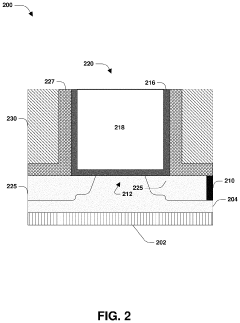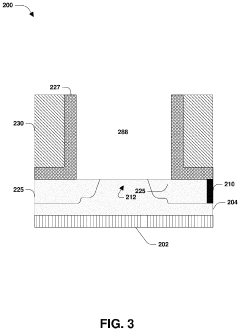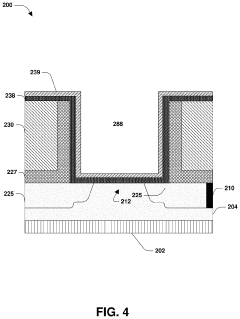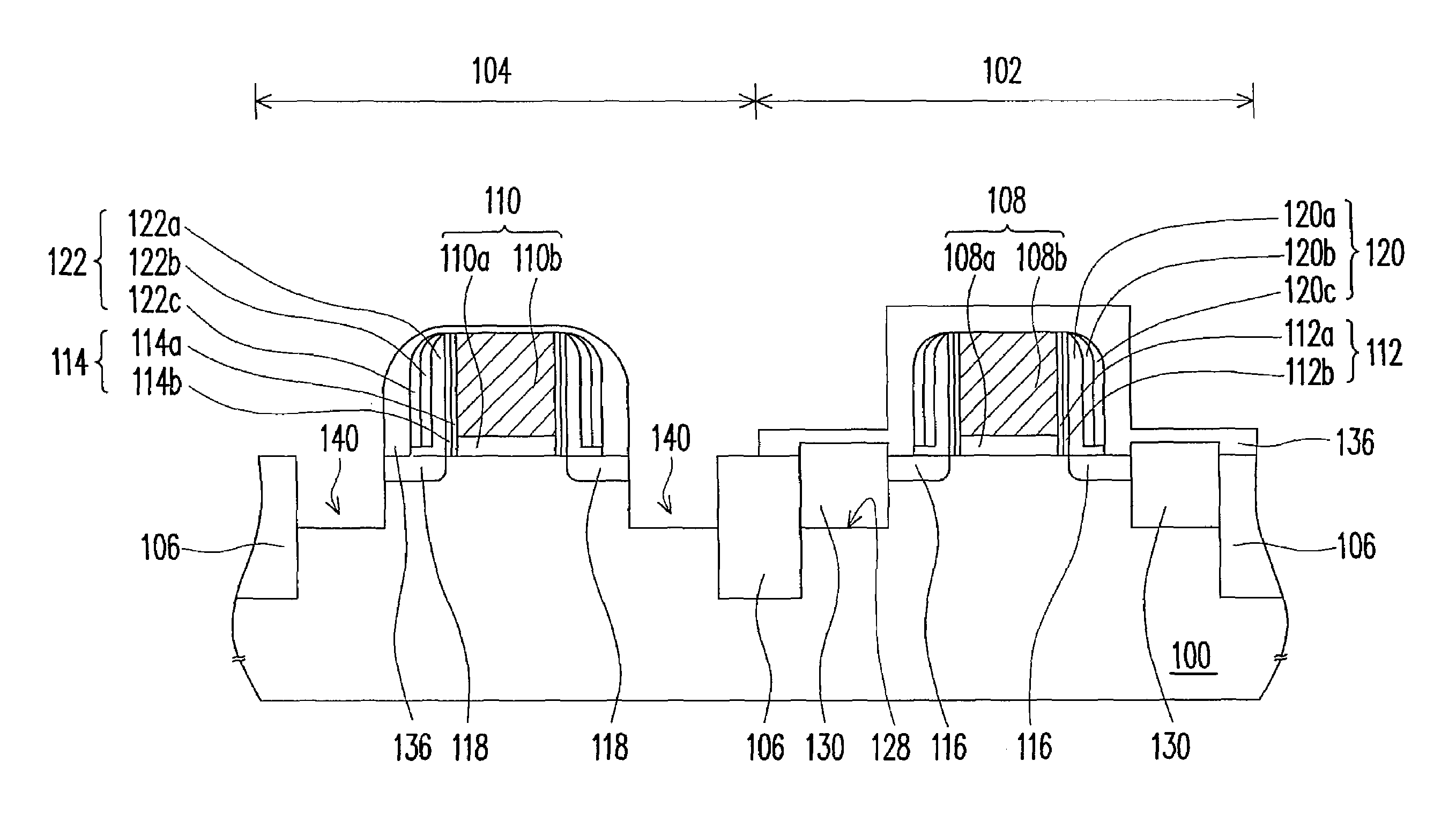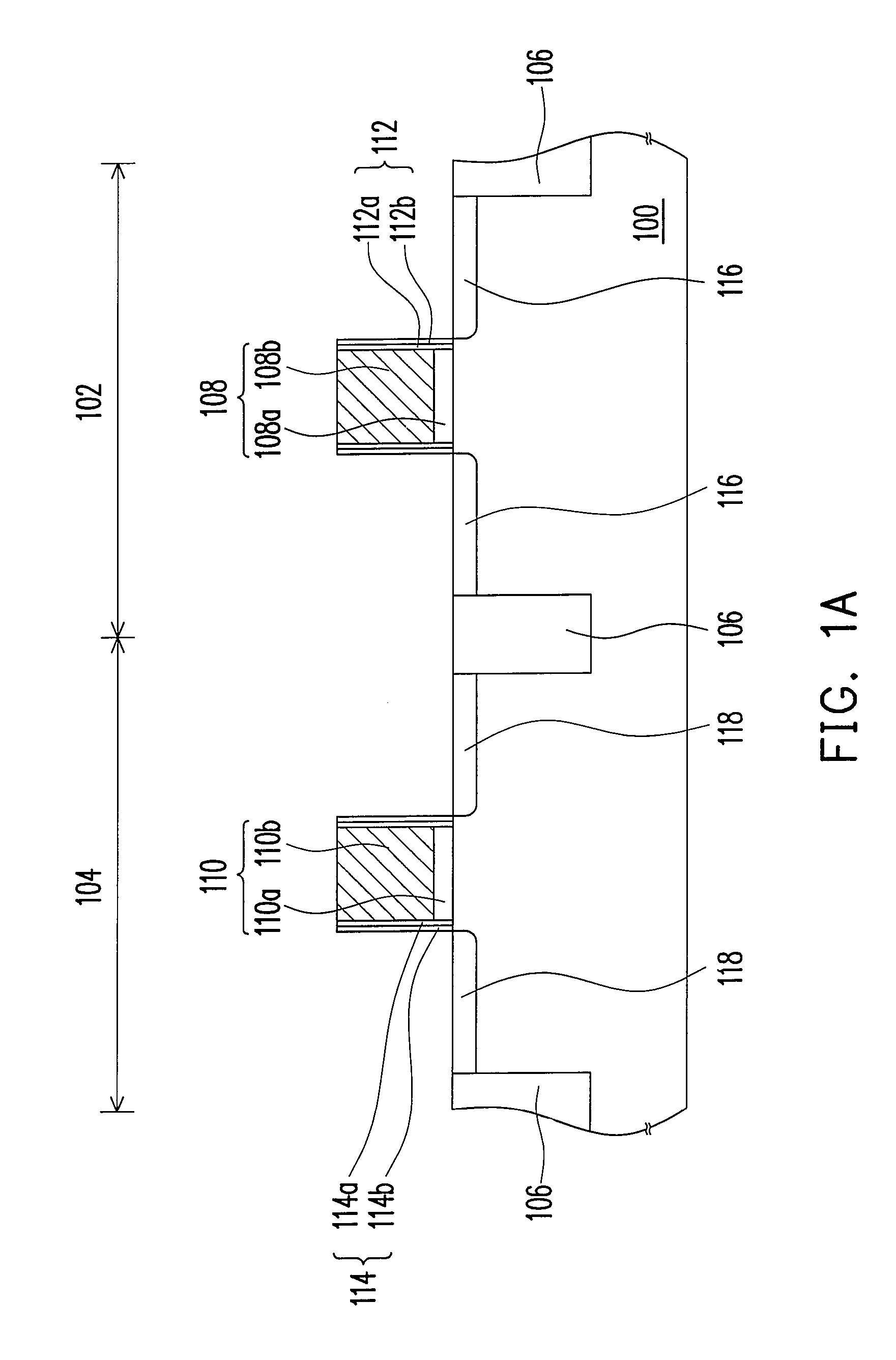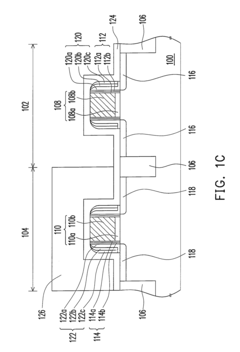How CMOS Battery Guides Inclusive Innovative Software Constructs?
JUL 22, 20259 MIN READ
Generate Your Research Report Instantly with AI Agent
Patsnap Eureka helps you evaluate technical feasibility & market potential.
CMOS Battery Evolution
The evolution of CMOS battery technology has been a crucial factor in the development of modern computing systems. Initially introduced in the 1980s, CMOS (Complementary Metal-Oxide-Semiconductor) batteries were designed to maintain system settings and real-time clock information when a computer was powered off. This seemingly simple function has had far-reaching implications for software development and system architecture.
In the early stages, CMOS batteries were primarily used to store basic system configuration data, such as time, date, and hardware settings. As computer systems became more complex, the role of CMOS batteries expanded to include maintaining BIOS (Basic Input/Output System) settings, which are critical for system boot-up and hardware initialization.
The reliability and longevity of CMOS batteries have significantly improved over time. Early versions often required replacement every few years, while modern CMOS batteries can last up to a decade or more. This increased lifespan has allowed for more stable and consistent system configurations, reducing maintenance requirements and improving overall system reliability.
As software complexity grew, CMOS batteries began to play a more significant role in supporting advanced features. They became instrumental in maintaining security settings, power management configurations, and even overclocking parameters for enthusiast-grade systems. This evolution has enabled more sophisticated software constructs that rely on persistent system-level settings.
The advent of UEFI (Unified Extensible Firmware Interface) as a successor to traditional BIOS has further expanded the importance of CMOS batteries. UEFI's more advanced features, such as secure boot and faster startup times, rely heavily on the persistent storage provided by CMOS batteries to maintain their configurations across power cycles.
In recent years, the integration of CMOS functionality into other system components has begun to challenge the traditional discrete CMOS battery. Some modern systems now use capacitor-based solutions or integrate CMOS functions into the main system battery, potentially eliminating the need for a separate CMOS battery altogether.
This evolution has had a profound impact on software development practices. Developers can now rely on persistent system settings to create more robust and feature-rich applications. The stability provided by long-lasting CMOS batteries has allowed for the implementation of complex software constructs that depend on consistent system configurations, enhancing both user experience and system functionality.
In the early stages, CMOS batteries were primarily used to store basic system configuration data, such as time, date, and hardware settings. As computer systems became more complex, the role of CMOS batteries expanded to include maintaining BIOS (Basic Input/Output System) settings, which are critical for system boot-up and hardware initialization.
The reliability and longevity of CMOS batteries have significantly improved over time. Early versions often required replacement every few years, while modern CMOS batteries can last up to a decade or more. This increased lifespan has allowed for more stable and consistent system configurations, reducing maintenance requirements and improving overall system reliability.
As software complexity grew, CMOS batteries began to play a more significant role in supporting advanced features. They became instrumental in maintaining security settings, power management configurations, and even overclocking parameters for enthusiast-grade systems. This evolution has enabled more sophisticated software constructs that rely on persistent system-level settings.
The advent of UEFI (Unified Extensible Firmware Interface) as a successor to traditional BIOS has further expanded the importance of CMOS batteries. UEFI's more advanced features, such as secure boot and faster startup times, rely heavily on the persistent storage provided by CMOS batteries to maintain their configurations across power cycles.
In recent years, the integration of CMOS functionality into other system components has begun to challenge the traditional discrete CMOS battery. Some modern systems now use capacitor-based solutions or integrate CMOS functions into the main system battery, potentially eliminating the need for a separate CMOS battery altogether.
This evolution has had a profound impact on software development practices. Developers can now rely on persistent system settings to create more robust and feature-rich applications. The stability provided by long-lasting CMOS batteries has allowed for the implementation of complex software constructs that depend on consistent system configurations, enhancing both user experience and system functionality.
Software Market Trends
The software market is experiencing significant shifts driven by the integration of CMOS battery technology into innovative software constructs. This trend is reshaping the landscape of software development and deployment, particularly in areas such as power management, system reliability, and real-time data processing.
One of the most notable market trends is the increasing demand for energy-efficient software solutions. As CMOS battery technology continues to evolve, software developers are leveraging its capabilities to create applications that optimize power consumption. This has led to a surge in the development of green computing solutions, with major tech companies investing heavily in software that can extend battery life and reduce overall energy usage.
The rise of edge computing has also been influenced by advancements in CMOS battery technology. Software designed to operate at the network edge is now capable of more complex operations without draining power resources. This has opened up new market opportunities in IoT, autonomous systems, and mobile computing, where real-time processing and low latency are critical.
Another significant trend is the growing market for software that enhances system reliability. CMOS batteries play a crucial role in maintaining system integrity during power fluctuations or outages. As a result, there's an increased focus on developing robust software solutions that can seamlessly integrate with CMOS battery systems to ensure uninterrupted operation and data preservation.
The financial services sector has seen a particular uptick in demand for software leveraging CMOS battery technology. Trading platforms and high-frequency trading systems are incorporating these innovations to maintain precise timekeeping and ensure transaction accuracy, even in the event of power disruptions.
In the healthcare industry, there's a growing market for medical devices with advanced software capabilities guided by CMOS battery technology. These devices offer improved reliability and longer operating times, critical for patient monitoring and life-support systems.
The automotive software market is also being transformed by CMOS battery-guided innovations. As vehicles become more electrified and autonomous, there's an increasing need for software that can manage complex power systems efficiently while ensuring the reliability of critical safety features.
Lastly, the cybersecurity software market is adapting to the challenges and opportunities presented by CMOS battery technology. New security solutions are being developed to protect the integrity of system clocks and prevent attacks that could exploit power management systems.
One of the most notable market trends is the increasing demand for energy-efficient software solutions. As CMOS battery technology continues to evolve, software developers are leveraging its capabilities to create applications that optimize power consumption. This has led to a surge in the development of green computing solutions, with major tech companies investing heavily in software that can extend battery life and reduce overall energy usage.
The rise of edge computing has also been influenced by advancements in CMOS battery technology. Software designed to operate at the network edge is now capable of more complex operations without draining power resources. This has opened up new market opportunities in IoT, autonomous systems, and mobile computing, where real-time processing and low latency are critical.
Another significant trend is the growing market for software that enhances system reliability. CMOS batteries play a crucial role in maintaining system integrity during power fluctuations or outages. As a result, there's an increased focus on developing robust software solutions that can seamlessly integrate with CMOS battery systems to ensure uninterrupted operation and data preservation.
The financial services sector has seen a particular uptick in demand for software leveraging CMOS battery technology. Trading platforms and high-frequency trading systems are incorporating these innovations to maintain precise timekeeping and ensure transaction accuracy, even in the event of power disruptions.
In the healthcare industry, there's a growing market for medical devices with advanced software capabilities guided by CMOS battery technology. These devices offer improved reliability and longer operating times, critical for patient monitoring and life-support systems.
The automotive software market is also being transformed by CMOS battery-guided innovations. As vehicles become more electrified and autonomous, there's an increasing need for software that can manage complex power systems efficiently while ensuring the reliability of critical safety features.
Lastly, the cybersecurity software market is adapting to the challenges and opportunities presented by CMOS battery technology. New security solutions are being developed to protect the integrity of system clocks and prevent attacks that could exploit power management systems.
CMOS-Software Interface
The CMOS-Software Interface represents a critical junction in modern computing systems, bridging the hardware-level CMOS (Complementary Metal-Oxide-Semiconductor) technology with higher-level software constructs. This interface plays a pivotal role in enabling innovative software solutions that leverage the unique capabilities of CMOS technology, particularly in relation to the CMOS battery.
The CMOS battery, a small lithium cell on the motherboard, powers the CMOS chip that stores essential system configuration data. This data includes hardware settings, system time, and BIOS information. The persistence of this information, even when the main power is off, creates a foundation for software innovations that rely on consistent system states and configurations.
One key aspect of the CMOS-Software interface is the BIOS (Basic Input/Output System) or more recently, UEFI (Unified Extensible Firmware Interface). These firmware interfaces act as intermediaries between the hardware-level CMOS and the operating system, providing a standardized way for software to interact with low-level hardware functions.
The CMOS-Software interface enables software developers to create applications that can read and write to the CMOS memory. This capability allows for the development of utilities that can manage system configurations, perform diagnostics, and even implement security features based on hardware-level information stored in the CMOS.
An important innovation guided by the CMOS battery is the development of power management software. The consistent timekeeping provided by the CMOS battery allows for sophisticated power-saving algorithms that can track system usage patterns and adjust power states accordingly, leading to more energy-efficient computing systems.
The interface also facilitates the creation of software-based system recovery tools. By leveraging the persistent nature of CMOS-stored information, these tools can restore system configurations even in cases of severe software failures, enhancing system reliability and user experience.
In the realm of security, the CMOS-Software interface enables the implementation of hardware-rooted security measures. Software can utilize the unique identifiers stored in CMOS to enhance authentication processes and protect against certain types of attacks.
As we move towards more interconnected and intelligent systems, the CMOS-Software interface is evolving to support new paradigms such as the Internet of Things (IoT) and edge computing. It provides a stable foundation for software that needs to manage diverse hardware configurations and maintain system integrity in distributed environments.
The interface's role in supporting virtualization technologies is also noteworthy. By providing a consistent hardware abstraction layer, it enables software to create and manage virtual machines efficiently, contributing to the flexibility and scalability of modern cloud computing infrastructures.
The CMOS battery, a small lithium cell on the motherboard, powers the CMOS chip that stores essential system configuration data. This data includes hardware settings, system time, and BIOS information. The persistence of this information, even when the main power is off, creates a foundation for software innovations that rely on consistent system states and configurations.
One key aspect of the CMOS-Software interface is the BIOS (Basic Input/Output System) or more recently, UEFI (Unified Extensible Firmware Interface). These firmware interfaces act as intermediaries between the hardware-level CMOS and the operating system, providing a standardized way for software to interact with low-level hardware functions.
The CMOS-Software interface enables software developers to create applications that can read and write to the CMOS memory. This capability allows for the development of utilities that can manage system configurations, perform diagnostics, and even implement security features based on hardware-level information stored in the CMOS.
An important innovation guided by the CMOS battery is the development of power management software. The consistent timekeeping provided by the CMOS battery allows for sophisticated power-saving algorithms that can track system usage patterns and adjust power states accordingly, leading to more energy-efficient computing systems.
The interface also facilitates the creation of software-based system recovery tools. By leveraging the persistent nature of CMOS-stored information, these tools can restore system configurations even in cases of severe software failures, enhancing system reliability and user experience.
In the realm of security, the CMOS-Software interface enables the implementation of hardware-rooted security measures. Software can utilize the unique identifiers stored in CMOS to enhance authentication processes and protect against certain types of attacks.
As we move towards more interconnected and intelligent systems, the CMOS-Software interface is evolving to support new paradigms such as the Internet of Things (IoT) and edge computing. It provides a stable foundation for software that needs to manage diverse hardware configurations and maintain system integrity in distributed environments.
The interface's role in supporting virtualization technologies is also noteworthy. By providing a consistent hardware abstraction layer, it enables software to create and manage virtual machines efficiently, contributing to the flexibility and scalability of modern cloud computing infrastructures.
Current CMOS Solutions
01 CMOS battery power management
Systems and methods for managing power in CMOS batteries, including techniques for monitoring battery voltage, implementing power-saving modes, and extending battery life through efficient power distribution and consumption in electronic devices.- CMOS battery power management: Systems and methods for managing power in CMOS batteries, including techniques for monitoring battery voltage, implementing power-saving modes, and extending battery life through efficient power distribution and consumption in electronic devices.
- CMOS battery replacement and backup systems: Innovations in CMOS battery replacement procedures and backup power systems to maintain critical data and settings during battery failure or replacement, ensuring continuous operation of electronic devices and preserving system configurations.
- Integration of CMOS batteries in semiconductor devices: Advancements in integrating CMOS batteries within semiconductor devices, including novel packaging techniques, on-chip battery solutions, and improved connectivity between the battery and other components to enhance overall device performance and reliability.
- CMOS battery monitoring and diagnostics: Development of sophisticated monitoring and diagnostic systems for CMOS batteries, incorporating sensors and algorithms to accurately assess battery health, predict failures, and provide real-time status updates to users or system administrators.
- Environmental and safety considerations for CMOS batteries: Innovations addressing environmental concerns and safety issues related to CMOS batteries, including eco-friendly battery designs, improved disposal methods, and enhanced protection against leakage or overheating in various electronic applications.
02 CMOS battery replacement and backup systems
Innovations in CMOS battery replacement procedures and backup power systems, ensuring continuous operation of critical components during battery changes or failures, and improving overall system reliability in various electronic devices.Expand Specific Solutions03 CMOS battery integration in semiconductor devices
Advancements in integrating CMOS batteries with semiconductor devices, focusing on miniaturization, improved performance, and enhanced compatibility with various electronic components and systems.Expand Specific Solutions04 CMOS battery charging and monitoring circuits
Development of specialized circuits for charging CMOS batteries and monitoring their status, including voltage regulation, charge level indication, and protection against overcharging or deep discharge.Expand Specific Solutions05 CMOS battery applications in imaging devices
Utilization of CMOS batteries in imaging devices such as cameras and sensors, focusing on power management for image processing, data retention, and maintaining device settings during power-off states.Expand Specific Solutions
Key Industry Players
The competitive landscape for CMOS battery technology in innovative software constructs is evolving rapidly, with the market currently in a growth phase. The global market size for this technology is expanding, driven by increasing demand for energy-efficient and long-lasting power solutions in various electronic devices. While the technology is relatively mature, ongoing innovations are pushing its boundaries. Key players like Taiwan Semiconductor Manufacturing Co., Ltd., IBM, and Qualcomm are leading the charge in research and development, focusing on integrating CMOS battery technology with advanced software constructs to enhance performance and efficiency in diverse applications.
Taiwan Semiconductor Manufacturing Co., Ltd.
Technical Solution: TSMC has made significant advancements in CMOS battery-aware process technologies that enable more efficient and inclusive software constructs. Their approach focuses on developing specialized semiconductor processes that optimize the interaction between CMOS circuitry and battery systems. TSMC's innovation includes the development of ultra-low leakage transistors and advanced power gating techniques that are specifically designed to work in harmony with CMOS battery characteristics[5]. This allows for the creation of more energy-efficient chips that can support complex software constructs without compromising on performance. Additionally, TSMC has introduced a novel "battery-adaptive logic" that can dynamically adjust circuit behavior based on the current state of the CMOS battery, enabling more intelligent power management at the hardware level[6].
Strengths: World-leading semiconductor manufacturing capabilities, cutting-edge process technologies. Weaknesses: Primarily focused on hardware solutions, may require partnerships for comprehensive software integration.
International Business Machines Corp.
Technical Solution: IBM has developed innovative software constructs that leverage CMOS battery technology to enhance system reliability and power management. Their approach integrates low-power CMOS circuitry with advanced software algorithms to optimize battery life and performance. IBM's solution includes intelligent power distribution systems that dynamically allocate energy resources based on real-time computational demands[1]. This technology enables seamless transitions between power states, reducing overall energy consumption while maintaining system responsiveness. Additionally, IBM has implemented machine learning models to predict battery degradation and optimize charging cycles, extending the lifespan of CMOS batteries in critical systems[3].
Strengths: Extensive experience in enterprise-level systems, strong R&D capabilities, and a vast patent portfolio. Weaknesses: Potential over-complexity for smaller-scale applications and higher implementation costs compared to simpler solutions.
CMOS Battery Innovations
Semiconductor device with profiled work-function metal gate electrode and method of making
PatentActiveUS11804409B2
Innovation
- The implementation of a semiconductor device with a metal gate electrode structure that includes a profiled work-function metal gate, comprising a high-k gate dielectric layer, a barrier layer, an intermediate work-function metal layer, and a work-function adjustment layer, formed through a series of deposition and annealing processes to achieve a crystalline work-function metal layer with ordered grain orientation.
Complementary metal-oxide-semiconductor device and fabricating method thereof
PatentActiveUS7402496B2
Innovation
- A method involving the use of a carbon-containing oxynitride passivation layer with a low etching rate, formed through low-pressure chemical-vapor deposition, is employed to prevent the improper removal of the passivation layer during device manufacturing, and a thermal process is applied to densify the passivation layer, reducing the etching rate and avoiding the formation of poly bumps.
Energy Efficiency Impact
The impact of CMOS battery technology on energy efficiency in innovative software constructs is multifaceted and significant. CMOS batteries, while small in size, play a crucial role in maintaining system settings and real-time clock functions in computer systems. Their energy efficiency characteristics have far-reaching implications for software development and system performance.
CMOS batteries are designed to consume minimal power, typically lasting for several years without replacement. This longevity is achieved through advanced power management techniques and low-power circuit designs. The energy-efficient nature of CMOS batteries allows for continuous operation of critical system functions without significantly impacting overall power consumption.
In the context of inclusive innovative software constructs, the energy efficiency of CMOS batteries enables developers to create more power-conscious applications. By relying on the consistent and low-power operation of CMOS-maintained settings, software can be designed to optimize power usage across various system components. This is particularly important in mobile and embedded systems where battery life is a critical factor.
The energy efficiency of CMOS batteries also contributes to the reliability and stability of software systems. By providing a stable power source for maintaining system configurations, CMOS batteries reduce the likelihood of data corruption or loss due to power fluctuations. This stability allows software developers to focus on creating more robust and efficient code, without the need for excessive error-handling routines related to system configuration issues.
Furthermore, the low power consumption of CMOS batteries aligns with the growing trend of green computing. Software constructs that leverage CMOS technology can contribute to overall system energy efficiency, reducing the carbon footprint of computing devices. This aspect is increasingly important as environmental concerns drive the development of more sustainable technology solutions.
The energy efficiency impact extends to software performance optimization as well. With stable and reliable system settings maintained by CMOS batteries, software can be designed to make more accurate assumptions about the underlying hardware configuration. This leads to more efficient resource allocation and improved overall performance, without the need for constant reconfiguration or system checks.
In conclusion, the energy efficiency of CMOS batteries plays a vital role in guiding the development of inclusive innovative software constructs. It enables the creation of more power-conscious, reliable, and environmentally friendly applications, while also contributing to improved software performance and stability across a wide range of computing devices.
CMOS batteries are designed to consume minimal power, typically lasting for several years without replacement. This longevity is achieved through advanced power management techniques and low-power circuit designs. The energy-efficient nature of CMOS batteries allows for continuous operation of critical system functions without significantly impacting overall power consumption.
In the context of inclusive innovative software constructs, the energy efficiency of CMOS batteries enables developers to create more power-conscious applications. By relying on the consistent and low-power operation of CMOS-maintained settings, software can be designed to optimize power usage across various system components. This is particularly important in mobile and embedded systems where battery life is a critical factor.
The energy efficiency of CMOS batteries also contributes to the reliability and stability of software systems. By providing a stable power source for maintaining system configurations, CMOS batteries reduce the likelihood of data corruption or loss due to power fluctuations. This stability allows software developers to focus on creating more robust and efficient code, without the need for excessive error-handling routines related to system configuration issues.
Furthermore, the low power consumption of CMOS batteries aligns with the growing trend of green computing. Software constructs that leverage CMOS technology can contribute to overall system energy efficiency, reducing the carbon footprint of computing devices. This aspect is increasingly important as environmental concerns drive the development of more sustainable technology solutions.
The energy efficiency impact extends to software performance optimization as well. With stable and reliable system settings maintained by CMOS batteries, software can be designed to make more accurate assumptions about the underlying hardware configuration. This leads to more efficient resource allocation and improved overall performance, without the need for constant reconfiguration or system checks.
In conclusion, the energy efficiency of CMOS batteries plays a vital role in guiding the development of inclusive innovative software constructs. It enables the creation of more power-conscious, reliable, and environmentally friendly applications, while also contributing to improved software performance and stability across a wide range of computing devices.
Inclusive Tech Standards
Inclusive tech standards play a crucial role in guiding the development of innovative software constructs that leverage CMOS battery technology. These standards ensure that software solutions are accessible, usable, and beneficial to a diverse range of users, regardless of their abilities, backgrounds, or technological expertise.
One key aspect of inclusive tech standards in this context is the implementation of power-aware design principles. Software constructs must be optimized to efficiently utilize the limited power resources provided by CMOS batteries, while still maintaining functionality and accessibility for all users. This includes developing adaptive power management algorithms that can adjust system performance based on user needs and battery status, ensuring that critical functions remain available even under low-power conditions.
Interoperability is another essential component of inclusive tech standards for CMOS battery-guided software constructs. Standards must be established to ensure seamless integration between hardware components and software systems across different devices and platforms. This allows for greater flexibility in implementation and enables users with various devices to access and benefit from the software solutions.
Accessibility features are paramount in inclusive tech standards. Software constructs must incorporate design elements that accommodate users with diverse abilities, such as adjustable font sizes, color contrast options, and voice control interfaces. These features should be seamlessly integrated into the core functionality of the software, rather than being treated as add-ons or afterthoughts.
Data privacy and security standards are also critical in ensuring inclusivity. As CMOS battery-guided software constructs often involve the collection and processing of user data for power optimization and personalization, robust security measures must be in place to protect user information. This includes implementing encryption protocols, secure data storage practices, and transparent data usage policies that are easily understandable by users of all backgrounds.
Inclusive tech standards must also address the issue of digital literacy. Software constructs should be designed with intuitive interfaces and clear documentation that cater to users with varying levels of technological proficiency. This may involve the development of multi-modal interaction methods, such as voice commands, gesture controls, and simplified user interfaces, to accommodate different user preferences and abilities.
Furthermore, inclusive tech standards should promote the use of open-source technologies and standardized protocols. This approach fosters innovation and collaboration within the developer community, leading to more diverse and inclusive software solutions. It also ensures that smaller organizations and individual developers can contribute to and benefit from advancements in CMOS battery-guided software constructs, promoting a more equitable technological landscape.
One key aspect of inclusive tech standards in this context is the implementation of power-aware design principles. Software constructs must be optimized to efficiently utilize the limited power resources provided by CMOS batteries, while still maintaining functionality and accessibility for all users. This includes developing adaptive power management algorithms that can adjust system performance based on user needs and battery status, ensuring that critical functions remain available even under low-power conditions.
Interoperability is another essential component of inclusive tech standards for CMOS battery-guided software constructs. Standards must be established to ensure seamless integration between hardware components and software systems across different devices and platforms. This allows for greater flexibility in implementation and enables users with various devices to access and benefit from the software solutions.
Accessibility features are paramount in inclusive tech standards. Software constructs must incorporate design elements that accommodate users with diverse abilities, such as adjustable font sizes, color contrast options, and voice control interfaces. These features should be seamlessly integrated into the core functionality of the software, rather than being treated as add-ons or afterthoughts.
Data privacy and security standards are also critical in ensuring inclusivity. As CMOS battery-guided software constructs often involve the collection and processing of user data for power optimization and personalization, robust security measures must be in place to protect user information. This includes implementing encryption protocols, secure data storage practices, and transparent data usage policies that are easily understandable by users of all backgrounds.
Inclusive tech standards must also address the issue of digital literacy. Software constructs should be designed with intuitive interfaces and clear documentation that cater to users with varying levels of technological proficiency. This may involve the development of multi-modal interaction methods, such as voice commands, gesture controls, and simplified user interfaces, to accommodate different user preferences and abilities.
Furthermore, inclusive tech standards should promote the use of open-source technologies and standardized protocols. This approach fosters innovation and collaboration within the developer community, leading to more diverse and inclusive software solutions. It also ensures that smaller organizations and individual developers can contribute to and benefit from advancements in CMOS battery-guided software constructs, promoting a more equitable technological landscape.
Unlock deeper insights with Patsnap Eureka Quick Research — get a full tech report to explore trends and direct your research. Try now!
Generate Your Research Report Instantly with AI Agent
Supercharge your innovation with Patsnap Eureka AI Agent Platform!

